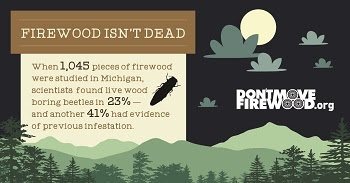| Oct. 6, 2021
Make safe firewood choices to protect the places you love
This October, support Firewood Month by choosing to buy firewood where you burn it to prevent the spread of tree pests and diseases. As natural resource managers across the state work to limit tree loss from oak wilt, hemlock woolly adelgid and other destructive invaders, you can do your part by making safe firewood choices.
Invasive species, those that are not native and cause harm to the environment, economy or human health, are often transported to new locations through human means. Most tree pests and diseases get to new destinations in contaminated plant material or infested wood products, including firewood.
 According to the Michigan Department of Agriculture and Rural Development, there are 140 pests and diseases that can be moved with firewood. Some are already present in Michigan, while others, including Asian longhorned beetle, beech leaf disease and spotted lanternfly, are infesting nearby states. According to the Michigan Department of Agriculture and Rural Development, there are 140 pests and diseases that can be moved with firewood. Some are already present in Michigan, while others, including Asian longhorned beetle, beech leaf disease and spotted lanternfly, are infesting nearby states.
Recreational lands in Michigan are showing the effects of invasive tree pests and diseases. For example, P.J. Hoffmaster State Park has lost over 1,000 trees from oak wilt, transforming once-shady campsites and healthy wildlife areas into barren, open space.
“Michigan’s beautiful fall foliage, recreational spaces, timber and landscape trees are at risk from invasive tree pests and diseases,” said Susannah Iott, MDARD invasive species program specialist. “Infestations can destroy forests, lower property values and cost huge sums of money to control.” |
Harmful invasive species may be invisible to the naked eye and can hide in or on firewood. While most cannot move too far on their own, these pests and diseases can be transported undetected on firewood, starting new infestations in locations hundreds of miles away.
 “The best way to protect forests and landscape trees is to use locally sourced firewood or wood certified by the U.S. Department of Agriculture as heat-treated to kill pests and diseases,” said Iott. “This takes the guesswork out of determining if wood is infested with insects or infected with disease. “The best way to protect forests and landscape trees is to use locally sourced firewood or wood certified by the U.S. Department of Agriculture as heat-treated to kill pests and diseases,” said Iott. “This takes the guesswork out of determining if wood is infested with insects or infected with disease. |
Hunters, anglers, recreational vehicle owners and everyone who enjoys fall recreation can protect their favorite destinations for wildlife, themselves and future generations by preventing the spread of forest pests on firewood.
Make the simple choice to leave firewood at home and use one of these alternatives:
- Buy firewood where you’ll burn it.
- Buy certified heat-treated firewood.
- Gather firewood on site when permitted.
Hundreds of firewood vendors in Michigan are listed on FirewoodScout.org, making it easy to locate firewood distributors near your destination. The site also provides information on quarantines, rules and regulations to help with your firewood choices.
Heading out of state? It’s important to know that transporting firewood may violate state and federal laws depending on the region. More information including a map of firewood rules, regulations and recommendations for U.S. states and Canada, is available at Don’tMoveFirewood.org.
Michigan’s Invasive Species Program is cooperatively implemented by the Department of Environment, Great Lakes, and Energy, the Department of Natural Resources; and the Department of Agriculture and Rural Development.
/Note to editors: Accompanying photos are available below for download. Suggested caption information follows.
Firewood isn’t dead: Infographic provided by The Nature Conservancy.
Transporting firewood: Infographic provided by The Nature Conservancy.
Certified: A certification stamp and the name and address of the firewood supplier should be visible on any certified firewood label. Photo courtesy of the U.S. Army Corps of Engineers.
Buy-burn: To prevent spreading invasive pests and diseases, buy firewood near or at your destination.
Hoffmaster: Over 1,000 trees have been removed from the campground at P.J. Hoffmaster State Park in Muskegon due to an infestation of oak wilt./ |





